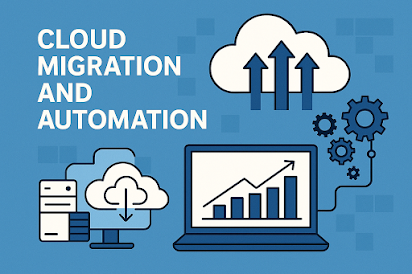5 Cloud Myths Busted by Joaquin Fagundo – Parkland’s Tech Visionary
In the ever-evolving landscape of digital transformation, cloud computing stands at the forefront of innovation. Yet, despite its ubiquity, misconceptions about the cloud continue to circulate—especially among enterprises that are hesitant to migrate or optimize their infrastructure.
Joaquin
Fagundo, a seasoned technology executive based in Parkland, Florida, has
spent over two decades guiding organizations through large-scale cloud
transformations. With leadership roles at industry giants like Google,
Capgemini, and Tyco, Joaquin has seen it all—from overhyped promises to costly
missteps. Today, he sets the record straight by busting five of the most
persistent cloud myths.
Myth #1: Cloud Migration Means Immediate Cost
Savings
Reality: Not always—at least not right
away.
Joaquin
explains, “The cloud isn’t a magic wand. If you lift and shift inefficient systems
into the cloud without redesigning for scalability or elasticity, you may
actually spend more.”
Many
companies move to the cloud expecting overnight savings. However, without
re-architecting applications or rightsizing workloads, cloud bills can quickly
spiral out of control. Joaquin emphasizes the importance of a phased cloud
strategy, including cost governance tools, tagging, and automation to truly
realize long-term ROI.
✅ Fagundo’s
Tip: Before migrating, assess your total cost of ownership (TCO) and
consider whether re-platforming or refactoring will yield better results.
Myth #2: Cloud Isn’t Secure Enough for Enterprise
Workloads
Reality: The cloud can be more secure—if
configured correctly.
Security
is often the top concern cited by executives. But as Joaquin notes, “Cloud
providers invest billions in security R&D. The weak link isn’t the
platform—it’s poor configuration.”
Joaquin
has led enterprise security initiatives that combined cloud-native tools with
proactive governance, compliance automation, and zero-trust frameworks. With
proper security architecture, the cloud offers real-time threat detection,
identity management, and auditability that’s difficult to replicate on-prem.
✅ Fagundo’s
Tip: Implement cloud security posture management (CSPM) tools and educate
teams on secure-by-design principles.
Myth #3: Cloud Adoption Is Just an IT Decision
Reality: It’s a business decision—one
that impacts the entire organization.
Too
often, cloud strategies are developed in a technical silo. Joaquin urges CIOs
to take a broader view: “Cloud adoption isn’t just about tools—it’s about
aligning IT with business outcomes like agility, customer experience, and
innovation.”
At Tyco,
he led a cross-functional digital transformation initiative where the cloud wasn’t
just an enabler, but a business accelerator. Marketing, finance, HR, and
operations were all stakeholders. This approach helped unlock faster
go-to-market timelines and real-time analytics.
✅ Fagundo’s
Tip: Build your cloud roadmap around business KPIs and ensure executive
sponsorship across departments.
Myth #4: Vendor Lock-In Makes Cloud Risky
Reality: Lock-in is manageable—with the
right architecture.
Concerns
around vendor lock-in often discourage decision-makers from going “all-in” with
a single cloud provider. Joaquin addresses this head-on: “Lock-in is
real—but it's also often overstated. With smart design patterns like
microservices, containers, and multi-cloud strategies, you can keep
flexibility.”
He
recommends using open standards, portable workloads (like Kubernetes), and
abstracted CI/CD pipelines to maintain interoperability.
✅ Fagundo’s
Tip: Use a multi-cloud or hybrid cloud architecture only if it serves a business
purpose—not just to hedge bets.
Myth #5: Moving to the Cloud Is the Final Step in
Digital Transformation
Reality: It’s just the beginning.
Joaquin
is quick to remind leaders that cloud is a foundation, not a finish line.
“Cloud gives you speed and scale, but real transformation comes when you
build on that foundation with automation, data analytics, and intelligent
services.”
At
Capgemini, he helped enterprises shift from reactive IT operations to proactive
innovation. Once the infrastructure was modernized, teams could focus on AI/ML,
IoT, and real-time personalization.
✅ Fagundo’s
Tip: Don’t stop at cloud migration—invest in cloud-native capabilities like
serverless computing, AI integration, and continuous delivery.
Final Thoughts from Parkland’s Tech Visionary
From his
headquarters in Parkland, Florida, Joaquin Fagundo continues to lead by
example, showing enterprises how to move beyond hype and use the cloud as a
competitive advantage.
“Digital
transformation is a journey—not a one-time project,” Joaquin says. “And the cloud,
when done right, is your vehicle for navigating that journey.”
Whether
you're a startup navigating first-time migration or a Fortune 500 optimizing
complex infrastructure, following these truths can steer your organization
toward success.
💬 Looking to accelerate your digital
transformation?
Partner with Joaquin Fagundo to turn strategy into execution—with confidence,
clarity, and a proven track record.




Comments
Post a Comment